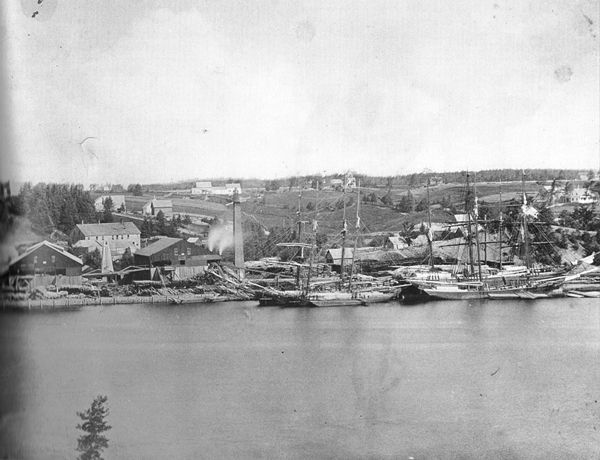B A C K T H E N
Steam Sawmill at East Hampden

Photo courtesy of Paul T. Stubing
The C.G. Sterns steam sawmill at East Hampden, on the Penobscot, just below Bangor. The photo was likely taken shortly after the refurbishment of the south mill in 1883. Built in 1854 by Hinckley & Edgerly, Bangor machinists, the mill was sold to Sterns, a Brewer sawmiller, in 1862. Likely it was equipped with gang saws for producing boarding, and circular saws for dimensional lumber. The mill also produced large amounts of “short lumber,” i.e., staves, pickets, laths, and so on. In 1892, the north mill was torn down and rebuilt as a bandsaw mill. Symbolic of the shifting center of the lumber industry, the millwright came from Wisconsin.
Bangor, the great lumber town, had not a single sawmill within city limits, but there were mills up the river, down the river, and across the river. In addition to the up-river water-powered mills, six slab-fired steam mills were located below the Bangor Dam, with two at East Hampden. The steam mills obtained their logs from the “steam mill drives” – in 1886, there were seven, totaling 50 million feet–from the Old Town boom to the Bangor boom. At the Bangor boom, logs were rafted for delivery. These drives continued until late fall, leaving the mills with sufficient stockpiles for spring sawing. At high tide, logs for Sterns were floated through a gate, located at the far right of the photo, into a storage pond. Logs were drawn out of the pond and into the mill by an endless chain; sawn lumber may be seen sliding down a chute from the north mill.
A half-brig and a bark lie alongside the wharf; two two-masted schooners– one is a monster–lie outboard. A third schooner lies beyond the bark. The schooners are receiving deckloads of lumber loaded from scows; a scow is being loaded at the north mill. The brig and the schooners are floating deep in the fresh water, but they will gain freeboard in more buoyant salt water.
The bark looks to be a foreigner–round-sided cabins were not a feature of American vessels—and by law is bound for a foreign port, as may be the brig. However, the vast majority of lumber sawn at Bangor in the ’80s was spruce that was carried out by small schooners to Boston and New York.
Sawmills subdivided more than logs:
Shortly before nine o’clock, yesterday forenoon, the steam mill of Hodgkins, Hall & Co., in East Hampden, was the scene of a very shocking accident. Some trouble had been noticed with the gang saw, and Mr. Benjamin L. Simpson, who has had general charge of all machinery in the mill, endeavored with a piece of wood to move a large belt to the pulley and thus bring the saw to a stop. While thus engaged he was precipitated on the belt, the result being that he was carried around the drum. The body of the unfortunate man was terribly crushed and his head was mangled in a horrible manner. Death undoubtedly resulted instantly. Medical attendants were summoned promptly but their services were unneeded. –Bangor Daily Commercial, May 14, 1884.
The building beyond the mills looks to be the boardinghouse. A droll Bucksporter described the seasonal vacating of a local mill’s boardinghouse:
The Hotel de Lathe-mill has closed for the season and has quite a lonesome appearance. The wide verandahs are no longer thronged with guests and the lawn tennis ground is deserted. The grand staircase has but a decimated and scattered high-low-jack deck and a job lot of second hand chewing tobacco where once the costly tapestry was spread. Gone are the clerks, bartenders, barbers, chambermaids, chef, all. Anon a twelvemonth will roll around, laths will be ripe enough to pick, down will come the gay gentlemen from the St. Francis, Mirimichi, Cape Breton and South Brewer and the deserted hostelry will be as gay as of yore.–The [Bangor] Industrial Journal, May 14, 1893.
Before Bangor’s great lumber boom in the 1840s, Hampden had been the chief port on the Penobscot, its Long Wharf lined with barrels of West India molasses and rum. In February of 1886 the old wharf was covered, instead, with 10,000 newly made fish barrels, most of them headed for Gloucester and other Massachusetts fishing ports.
Like at least one other steam sawmill man, Sterns was also in the ice business. River frontage, cheap lumber, and plenty of sawdust lay right at hand. (The Boston & Bangor Steamboat Co. cut the ice used aboard their steamers from the Penobscot, off their wharf.) During winter, of course, the mills were shut down.
Text by William H. Bunting from A Day’s Work, A Sampler of Historic Maine Photographs, 1860-1920, Part I. Published by Tilbury House Publishers, Gardiner, Maine, 800-582-1899
